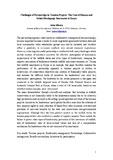| dc.description.abstract | The partnership approach (also known as collaborative management) has increasingly become important because it seeks to create negotiated agreements between state and local communities (other stakeholder groups may also be included) and therefore offers a possibility to overcome conflicts over natural resources exploitation. However, achieving successful partnership is confronted with many challenges which include creation of monetary incentives for effective participation of landowners, improvement of the wildlife status and other types of biodiversity, changing the negative perceptions of landowners towards wildlife and conservationists, etc. Taking two wildlife sanctuaries in Kenya as an example, this paper therefore analyses the performance of the partnership approach in tourism projects in relation to achievement of conservation objectives and creation of financially viable projects, and assesses the different kinds of incentives for landowners’ and other key stakeholders’ participation. The fieldwork for the results presented in this paper was conducted in the wildlife dispersal areas of Shimba Hills National Reserve and Amboseli National Park in Kenya, where a total of 136 households, based on two stratified random samples, were interviewed.
The paper demonstrates- through a benefit-cost analysis- that investing in wildlife conservation is not financially viable to the landowners mainly due to the relatively high production costs incurred in the setting up and operation activities of the tourism projects. Incentives for landowners’ participation therefore arise from the retention of their property rights to land, reduction of losses from other economic activities and provision of non-cash benefits by the state and conservation non-governmental organisations. Although there has been positive impacts on the wildlife status, the tourism projects have also resulted in a number of negative impacts. These include the failure to protect other types of biodiversity, prevention of free movement of wildlife, loss of landowners’ sites of socio-cultural values and lack of a compensation mechanism for landowners who are not members of the sanctuaries. | en |

